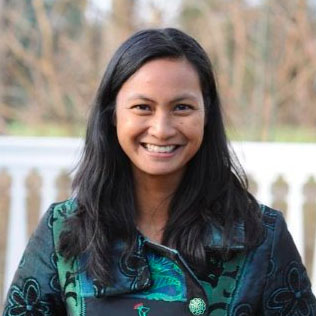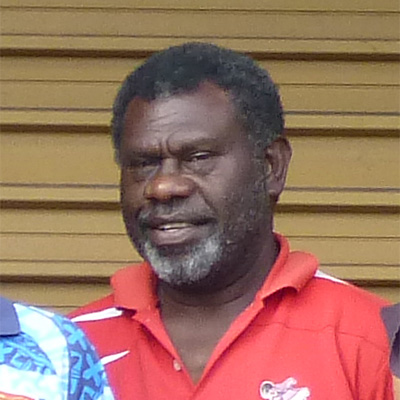
Members of the Port Resolution community going through the Q-method survey.
Different members of a community might have very different expectations and aspirations towards environmental and social change, natural resource management and economic opportunities. This has important implications on taking an ecosystem-based approach to climate change adaptation.
Approach
We undertook a study that surveyed the community of Port Resolution, on Tanna, to gain insights into these attitudes.
We set out to shed light on the following issues:
- To understand constraints and enabling factors for implementation of ecosystem-based adaptation.
- Find similarities and/or differences in how different people think and feel about development-focused activities.
- Identify specific issues for where there is community consensus, contention or ambivalence.
- Identify language and metaphors best-suited to communicating with community.
We used Q-methodology to reveal important ways of how people look at the world, or 'discourses', both within a community on Tanna and amongst stakeholders with knowledge of the challenges in the community to ascertain the barriers and enabling factors for implementation of EbAEbA Ecosystem-based adaptation - an adaptation approach to climate- and environmental-change which primarily deploys ecosystems and ecosystem functions to mitigate risks from hazards..
Q method is both a quantitative and a qualitative, based on statistical analysis of individuals subjectivity. It looks for commonalities amongst peoples’ views. These commonalities reflect mindsets that are analogous to the structure of a discourse.
Discourses are considered to be shaped by that person's feelings and experiences (internal) and be shaped by the community, power structures, and environment around them (external) to form collective storylines, or 'heuristics'.
Data was collected in the Port Resolution community by a team of researchers, ably assisted by two members of the community, Alfred and Ester.
The method of collection is for respondents to rank a series of statements from 'most important' to 'least important' on a large mat.
Findings
Our Q method study found 3 main discourses.
1. Strong Kastomkastom Kastom is a pidgin word (Bislama/English) used to refer to traditional culture, including religion, economics, art and magic in Melanesia. The word derives from the Australian English pronunciation of 'custom'. Kastom is mostly not written, only passed down through teachings and stories and includes places, stories, objects and animals and plants.
This group emphasised the importance of traditional and customary practices and had a preoccupation with sustainability of habitats that provided food and material and, to a slightly lesser extent, habitat functions that provide indirect benefits. The most important statements for this group were all in some way associated with kastom decision-making and kastom resource management. The statements connected with passing-on natural resources, knowledge, and customs down to future generations and concerns around garden productivity and managing fisheries were also important. This group of people placed little importance on further economic development opportunities associated with eco-tourism and support for the infrastructure that would support this. They also placed little emphasis on statements associated with access to financial services, electricity and voting and health. Statements related to childhood education were ranked neutrally.
2. Kastom + Health
Again, this group placed strong emphasis on traditional and customary preoccupations but have a generally had a lower concern with the sustainability of provisioning of food and material from the environment. However, importantly, this group showed strong support for modern health care, sanitation and water. One economic development statement was ranked quite strongly, indicating this perspective is a little more open to exploring income-generating opportunities, but not strongly so. This group was most worried about extreme weather associated with climate change. Three key kastom-related statements associated with sustaining traditional practices in the management of resources and practices remained salient. Similar to Strong Kastom, members of this group show low interest in statements associated with social change, such as access to information and financial services, economic development and voting. Statements related to childhood education were ranked neutrally.
3. Tentative Modernity
This group had a strong affinity to certain elements of kastom and customary management of resources, however, more so to statements related to ceremonial and cultural practices associated with retaining knowledge of dances and songs, rather than social relations between contemporaries. Distinguishing this factor from the others was the greater importance placed on income generating activities, such as tourism and handicrafts. Health-related statements were also ranked highly. In addition, and importantly, two female emancipatory statements are ranked highly. Ecosystem function statements were generally ranked lower. The affinity to economic development and emancipatory concepts signifies a desire for modernisation towards an exchange-based economy, however, the connection to kastom shows this affiliation is tentative. Statements related to childhood education were ranked neutrally.
Conclusions
The following conclusions can be drawn from this study:
- Likely a general preference for climate change adaptation based on ecosystem-based projects that provide indirect adaptation benefits + co-benefits.
- Projects need to be sensitive of the importance of Kastom resources management and knowledge.
But…
- Projects that support economic development (and challenge Kastom) may experience differences in support based on gender.
- Infrastructure provision and formal institutions (government) are considered unimportant.
Publication
Buckwell, A., Fleming, C., Muurmans, M., Smart, J. C. R., & Mackey, B. (2020b). Revealing the dominant discourses of stakeholders towards natural resource management in Port Resolution, Vanuatu, using Q-method. Ecological Economics, 177, 106781. https://doi.org/10.1016/j.ecolecon.2020.106781
Acknowledgements
This research was undertaken through an MOU with the Tafea Provincial Government and under a research agreement with the Vanuatu National Cultural Centre representing the Government of the Republic of Vanuatu and the local community. We are grateful to the Port Resolution community for their permission to undertake this research and for their cooperation, generosity, humour, and hospitality. In particular, we thank our research assistants in Port Resolution, Esther Karrahi and Alfred Iouma. Thanks also to Alan Dan, our Tanna Kastom advisor and community liaison. For the creative illustrations, we thank Sarah Engelhard and for additional research assistance in the field, we thank Johanna Loehr and Wade Hadwen. The research was also supported by a grant to Griffith University from a private charitable trust that wishes to remain anonymous. The donor had no influence on any aspect of the design, execution or documentation of this research.
About the lead authors:
Andrew Buckwell
Applied environmental and resource economist and social scientist.
Prof. Chris Fleming
Co-lead – Micro-economics, benefit-cost analysis, alternative indicators of well-being
Maggie Muurmans
PhD scholar – assisting with the EcoAdapt project.
Allan Dan
In-country project coordinator for Tanna and Vanuatu.
Request a copy of the article
If the download article link below doesn’t work, or leads to a page that requests payment, please click the link to the author profile above and request a copy directly and they will be happy to assist. Not all reviewed journal articles are published as ‘open access’, which are free to download.



